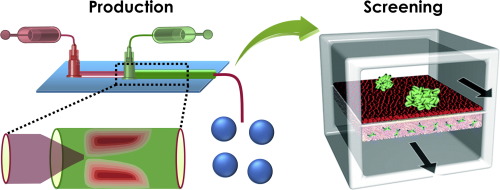Advanced Drug Delivery Reviews ( IF 15.2 ) Pub Date : 2017-08-08 , DOI: 10.1016/j.addr.2017.08.003 Dongfei Liu 1 , Hongbo Zhang 2 , Flavia Fontana 3 , Jouni T Hirvonen 3 , Hélder A Santos 1

|
Nanoparticulate drug delivery systems hold great potential for the therapy of many diseases, especially cancer. However, the translation of nanoparticulate drug delivery systems from academic research to industrial and clinical practice has been slow. This slow translation can be ascribed to the high batch-to-batch variations and insufficient production rate of the conventional preparation methods, and the lack of technologies for rapid screening of nanoparticulate drug delivery systems with high correlation to the in vivo tests. These issues can be addressed by the microfluidic technologies. For example, microfluidics can not only produce nanoparticles in a well-controlled, reproducible, and high-throughput manner, but also create 3D environments with continuous flow to mimic the physiological and/or pathological processes. This review provides an overview of the microfluidic devices developed to prepare nanoparticulate drug delivery systems, including drug nanosuspensions, polymer nanoparticles, polyplexes, structured nanoparticles and theranostic nanoparticles. We also highlight the recent advances of microfluidic systems in fabricating the increasingly realistic models of the in vivo milieu for rapid screening of nanoparticles. Overall, the microfluidic technologies offer a promise approach to accelerate the clinical translation of nanoparticulate drug delivery systems.
中文翻译:

微流控技术在纳米药物临床转化中的发展与应用
纳米颗粒给药系统在治疗许多疾病,尤其是癌症方面具有巨大潜力。然而,纳米颗粒给药系统从学术研究到工业和临床实践的转化一直很缓慢。这种缓慢的转化可以归因于传统制备方法的高批次间差异和生产率不足,以及缺乏与体内高度相关的纳米颗粒给药系统的快速筛选技术。测试。这些问题可以通过微流体技术来解决。例如,微流体不仅可以以良好控制、可重复和高通量的方式生产纳米粒子,还可以创建具有连续流动的 3D 环境来模拟生理和/或病理过程。本综述概述了为制备纳米颗粒药物递送系统而开发的微流体装置,包括药物纳米悬浮液、聚合物纳米颗粒、复合物、结构纳米颗粒和治疗诊断纳米颗粒。我们还强调了微流体系统在制造越来越逼真的体内模型方面的最新进展用于快速筛选纳米颗粒的环境。总体而言,微流体技术提供了一种有希望的方法来加速纳米颗粒药物递送系统的临床转化。











































 京公网安备 11010802027423号
京公网安备 11010802027423号